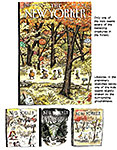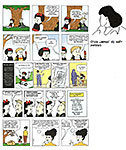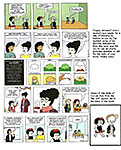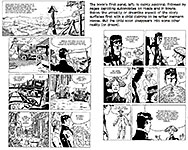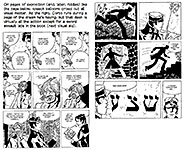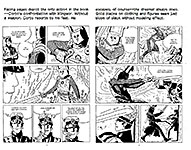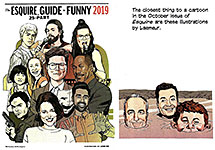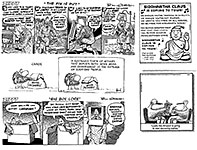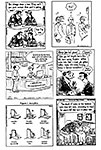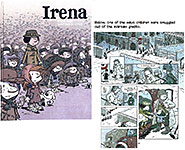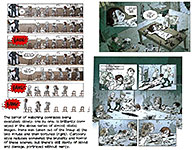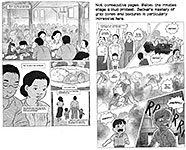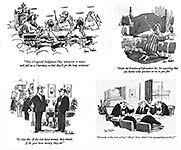 |
|||||||||||||||||||
Opus 397 (October 28, 2019). Down the old rabbit hole this time, we find reviews of “Watchmen” on tv, the Joker on the big screen and in Murphy’s comicbook, Olivia Jaimes’ Nancy, graphic novels Corto Maltese Secret Rose, Irena, They Called Us Enemy, plus news and obits for Bill Schelly and others—and more, much more, as you can tell by rolling an eyeball over the ensuing list of what’s here, by department, in order—:
Editor’s Note: The longest articles are marked with an asterisk (*) to help you decide which ones to visit right away and which ones to postpone to another day. Excessively long pieces get two asterisks (**).
BEFORE WE START How To Kill Off Democracy
NOUS R US Top 10 Graphic Novels in Classrooms Bechdel Makes the Dictionary Sesame Street’s 50th Archie Blue Ribbon and Katie Keene Making Comebacks—: The Boondocks Elfquest The Far Side Freddy the Pig Asterix on Currency in Europe Spider-Man Remains at MCU Feige Wins; Perllmutter Loses
ODDS & ADDENDA Underpants not Underwear McFarlane in Guinness Scorese and Ford Coppola Not Fans of Comicbook Movies Leto Not Joker Anymore
**WATCHMEN ON TV A Preview and a Review (Mine)
FUNNYBOOK FAN FARE *The Joker Is Back—: The Movie Murphy’s Curse of the White Knight
TRUMPERIES More Antic Outrageous Ignorances of Clown in Chief
EDITOONERY Postponed Until Next Time (I know: sob)
NEWSPAPER COMICS PAGE VIGIL Puzzles, Obscenity, Jake Tapper on Dilbert, Potty Talk —And More in the Funnies
RANCID RAVES GALLERY Two Notable Magazine Covers
The Black National Anthem By James Weldon Johnson
BOOK MARQUEE Short Reviews of—: Nancy by “Olivia Jaimes” The Secret Rose (Corto Maltese Adventure)
BOOK REVIEW Longer and Critical/Analytic of—: Studies in Comics (Scholarly Tome)
BOTTOM LINERS Single Panel Magazine Cartooning Some Examples Thereof
LONG FORM PAGEINATED CARTOON STRIPS Reviews of Graphic Novels—: Irena: Book One, Wartime Ghetto *They Called Us Enemy
ONWARD, THE SPREADING PUNDITRY A Miscellany of Actual Political News
PASSIN’ THROUGH Bill Schelly Dana Fradon Cokie Roberts Ram Mohan (India’s Father of Animation)
QUOTE OF THE MONTH If Not of A Lifetime “Goddamn it, you’ve got to be kind.”—Kurt Vonnegut
Our Motto: It takes all kinds. Live and let live. Wear glasses if you need ’em. But it’s hard to live by this axiom in the Age of Tea Baggers, so we’ve added another motto: Seven days without comics makes one weak. (You can’t have too many mottos.)
And in the same spirit, here’s—: Chatter matters, so let’s keep talking about comics.
And our customary reminder: don’t forget to activate the “Bathroom Button” by clicking on the “print friendly version” so you can print off a copy of just this installment for reading later, at your leisure while enthroned. Without further adieu, then, here we go—:
BEFORE WE START, THERE’S THIS—: It was John Adams who declared that “the government of the United States has been emphatically termed a government of laws, and not of men.” What, exactly, does that mean? How does a government of laws function that makes it different from a government by men? A government by men exists as long as there are men powerful enough to boss everyone else around. A government of laws functions like a game. It works as long as everyone plays by the rules, the laws. When people stop playing by those rules, that game, like any other game, deteriorates and soon ceases to be. Unhappily, we have a situation today of some people not playing by the rules. Trump has ordered that no one in the White House staff or in the State Department testify before the House committees that have subpoenaed them. Those who obey this order are not playing by the rules. If you’re subpoenaed, you must show up. That’s the rule, the law. People who disobey that law are undermining American democracy, a government by laws. And that makes Marie Yovanovitch, the former U.S. ambassador to Ukraine, a force for the reinstatement of government by law. She testified despite a White House declaration that there would be no more cooperation with Congress. In obeying a subpoena, she acted in defiance of the White House. But by testifying on Friday, October 12, she is playing by the rules, her behavior asserting that this is a government of laws, and to make the government work, the rules must be followed. If you don’t play the game by its rules, the game is pretty quickly over.
NOUS R US Some of All the News That Gives Us Fits
MAUS, MARCH LEAD TOP 10 LIST OF COMICS USED IN SCHOOLS The Comic Book Legal Defense Fund (CBLDF) released results of a survey on comics used in schools, reported slj.com, revealing the most-read comics in the classroom. The Top 10 were:
Maus by Art Spiegelman (Pantheon) March (trilogy) by John Lewis, Andrew Aydin, and Nate Powell (Top Shelf Productions) Persepolis by Marjane Satrapi (Pantheon) American Born Chinese by Gene Luen Yang (First Second) Amulet (series) by Kazu Kibuishi (Scholastic) Bone (series) by Jeff Smith (Scholastic) Understanding Comics by Scott McCloud (William Morrow Paperbacks) Ms. Marvel (series) by G. Willow Wilson et al (Marvel Comics) Smile by Raina Telgemeier (Scholastic) (tie) Dog Man (series) by Dav Pilkey (Scholastic) and Watchmen by Alan Moore and Dave Gibbons (DC Comics) The organization wanted to find out if comics are being used in schools, how they are being used, and if teachers encountered resistance in their efforts to incorporate comics in the classroom. Between May 10 and August 9th, 223 teachers responded to the online questionnaire. The majority (77 percent) of respondents said comics were used for independent reading; about 54 percent use them for supplemental instruction; and 40 percent use comics as "main unit assignments." More than half (54.8 percent) didn't face resistance at all. For those who did, the most opposition (31.2 percent) came from fellow teachers, followed by parents (19.1). The statistic is slightly suspect. Those who found the online questionnaire were probably fans of comics themselves and eagerly used them in the classroom. And that jacks up the usage factor. Those who aren’t fans of comicbooks probably never looked for the questionnaire. Still, however skewed, it’s nice to know.
BECHDEL MAKES THE BIG BOOK "Bechdel Test," named for cartoonist and graphic novelist Alison Bechdel, is one of 530 new words and phrases Merriam-Webster dictionary added in September, reports Sasha Goldstein at sevendaysvit.com. The definition reads: "A set of criteria used as a test to evaluate a work of fiction (such as a film) on the basis of its inclusion and representation of female characters." Bechdel introduced the world to the test in a 1985 Dykes to Watch Out For comic strip, in which two women try in vain to find a movie that passes a test with three criteria: "One, it has to have at least two women in it," the strip reads, "who, two, talk to each other about, three, something besides a man." Bechdel didn't know of the dictionary definition until Seven Days contacted her last week. "I'm very, very excited to have anything to do with a dictionary," Bechdel said. The cartoonist said the honor follows Stigler's law of eponymy, which states that no scientific discovery is named after its actual discoverer. Friend Liz Wallace thought up the Bechdel Test, according to Bechdel.
SESAME STREET’S 50TH Craig Yoe, once Creative Director/Vice President General Manager at the Muppet Palace, remembers its founder on the 50th anniversary of Sesame Street: Geez. I remember Jim Henson having me art direct a 20th anniversary logo for Sesame Street when working with him at the Muppets. Has time flown by so fast? The towering creative and caring Jim is long gone now, but that seems like yesterday, too. The heartfelt mission of dedicated people on and off screen brilliantly mixed with lovable fur, feather, and ping pong ball concocted critters endures.
ARCHIE KEEPS MOVIN’ ON And A Legendary Fashion Plate Moves In Archie Comics will continue their outreach with a new line of young adult original graphic novels in 2020 and will resurrect legendary fashion plate, Katy Keene. The new book imprint, Archie Blue Ribbon, will be targeting a bookstore market and filling a gap in the company’s current publishing program, which has primarily targeted comic book stores and newsstands. “At Archie, our goal is always to present the best story in the best format to reach the most readers,” Archie Comics Co-President Alex Segura told Scoop. Blue Ribbon’s launch titles will be Betty and Veronica: The Bond of Friendship by Jamie L. Rotante with art by Brittney Williams, followed by a Riverdale tie-in with Riverdale: The Ties That Bind by Micol Ostow and Thomas Pitilli. Both comics launch in 2020 and will be 144 pages. Katy Keene will join Archie both on CW’s tv show “Riverdale” and in Archie and Katy Keene No.1. The comicbook will debut in January 2020, and be written by Mariko Tamaki and Kevin Panetta, with art by Laura Braga. In it, the town of Riverdale is sent reeling after the “insta-famous” and ultra-fashionable Katy Keene shows up, and nobody is more competitive with her than Archie Andrews.
MAKING COMEBACKS “The Boondocks,” Elfquest, The Far Side, Freddie the Pig ●
Aaron McGruder’s animated
series based on his newspaper comic strip, The Boondocks, is being
revived with a two-season order, saith HBO Max. The revived show, re-imagined
by McGruder, will debut on the streaming service in fall 2020; the show’s
original 55 episodes will also be available. Quoted by the Washington Post’s Michael Cavna, McGruder said: “There’s a unique opportunity to revisit the
world of The Boondocks and do it over again for today. It’s crazy how
different the times we live in are now—both politically and culturally—more
than a decade past the original series and two decades past the original
newspaper comic. There’s a lot to say, and it should be fun.” ● Wendy and Richard Pini return this fall with a new series, Elfquest: Stargazer’s Hunt. When Elfquest: The Final Quest concluded, it ended the hero’s journey of Cutter Kinseeker, chief of the Wolfriders. But that was only the start of a new adventure for Cutter’s “brother in all but blood,” Skywise, the stargazer elf, who thought he knew everything about Cutter but learns how mistaken he was. A tragic accident involving his daughter, Jink, sends Skywise on a quest of his own from the elves’ ancestral Star Home through uncharted space and back to the World of Two Moons. Story by the Pinis with script by Wendy and art by Elfquest almni, Sonny Strait. ● Gary Larson’s iconic newspaper single-panel cartoon seems poised to return online. TheFarSide.com changed its homepage art to some of Larson’s creatures being thawed out by a blow-torch and offered a fresh message, said Cavna. “Uncommon, unreal, and (soon-to-be) unfrozen. A new online era of The Far Side is coming!” Cavna added that the return could mean a mix of archival material and new art from Larson. ● I discovered Freddy the Pig when I was in fifth grade, and I spent most of that year and the next reading about him. From 1927 to 1958, Walter R. Brooks wrote 26 books starring one of the great characters in American children’s literature, the aforementioned Freddy, who, when he stands on his hind legs and puts on people clothing, looks like a short pink-faced chubby fellow. Whenever there’s trouble on the Bean Farm, Freddy rises to the occasion and is by turns cowboy, explorer, politician, publisher, poet, magician, banker, campaign manager, pilot, and ace detective—to mention a few of the guises he assumes to solve the problem. The series was reintroduced in 2001 and is presented again with Kurt Wiese’s superb drawings in handsome hardcover British editions by Duckworth Overlook, available at daedalusbooks.com.
Asterix on the New Two-Euro Coin
SPIDER-MAN STILL IN MCU Scoop reports that Sony and Disney have reached a deal for Tom Holland’s Spider-Man to remain in the Marvel Cinematic Universe for a third film in the series. Marvel Studios president Kevin Feige will produce the new film with Amy Pascal producing through her Pascal Pictures. “I am thrilled that Spidey’s journey in the MCU will continue, and I and all of us at Marvel Studios are very excited that we get to keep working on it,” Feige said in a statement, adding: “Spider-Man is a powerful icon and hero whose story crosses all ages and audiences around the globe. He also happens to be the only hero with the superpower to cross cinematic universes, so as Sony continues to develop their own Spidey-verse you never know what surprises the future might hold.”
FEIGE IN CONTROL; PERLMUTTER DIMINISHED Marvel Studios head Kevin Feige has been given creative control of publishing, animation, and television in addition to film content, according to Hollywood Reporter (and related to us by Milton Griepp at ICv2 on October 16). The move unifies control of Marvel’s creative content under Feige, who has proven his worth to the company through an uninterrupted series of hit films set in the Marvel Cinematic Universe. The change further diminishes the portfolio of Marvel CEO Ike Perlmutter, who has been losing ground since 2015, when he lost Marvel Studios to Feige, and continued earlier this year, when Feige was given control of the new Marvel tv series produced for Disney. Dan Buckley will continue as President of Marvel Entertainment, a position he assumed in early 2017, but will now report to Feige on creative matters and to Perlmutter on publishing operations, sales, creative services, games, licensing and events, according to the report. Other creative executives under Buckley remain the same. No word on what will happen to current head of Marvel television Jeph Loeb.
ODDS & ADDENDA In an October 11 interview with Michael Cavna at the Washington Post’s Comics Riff, Dav Pilkey gives credit to his second grade teacher for Captain Underpants. “She mentioned underwear in class and everyone laughed and I was like: ‘Oh, that’s a good subject. I’ll do something with that.’ And so that was that.” Well, not quite. “Underpants” is funnier than “underwear,” and Pilkey evidently knew that. Spawn creator Todd McFarlane was awarded a Guinness World Record for the longest-running creator-owned superhero comic book series for the release of Spawn No.301. With this issue, ICv2 reported, Spawn has passed Cerebus, which reached 300 issues in 2004. (But Cerebus’ 300 issues were all drawn by its creator, Dave Sim— admittedly with Gerhard assisting on backgrounds, starting with No.65; McFarlane, as I understand it, has surrendered numerous whole issues of Spawn to other hands.) McFarlane received his award from Guinness World Records adjudicator Claire Elise Strephens at a panel during the New York Comic Con. “Any record that is based on longevity is made on the backs of dozens of people," McFarlane said. "As much as I am proud to be receiving this award, I gratefully accept it on behalf of all those who helped me the past 27 years on this journey." In mid-October, Martin Scorsese set off a minor firestorm when he revealed that he believes Marvel superhero movies are "not cinema" — and like an Avengers of Auteurs, his fellow directors have all assembled to back him up. According to The Hollywood Reporter, the latest is Frances Ford Coppola, director of “The Godfather” and “The Godfather Part II” and (sigh) “The Godfather Part III,” who said he believes Scorsese is right. Coppola added that he thinks Marvel movies are "despicable," The runaway success of the new Joker movie, which stars Joaquin Phoenix, has left at least one person without a smile: Jared Leto, who played the Joker in 2016's critically maligned “Suicide Squad,” and had hoped to reprise the role. When the rival Joker first came to his attention, said The Hollywood Reporter, Leto reportedly told his agents that they should try to stop the movie from being produced, fearing — correctly! — that it would get in the way of his own plans for the character. The report also says the version of the Joker played by Leto is unlikely to return in any future D.C. Comics movies — which is probably for the best, since Leto seems to be the only one who had any interest in seeing him again.
Fascinating Footnit. Much of the news retailed in the foregoing segment is culled from articles indexed at https://www.facebook.com/comicsresearchbibliography/, and eventually compiled into the Comics Research Bibliography, by Michael Rhode, which covers comic books, comic strips, animation, caricature, cartoons, bandes dessinees and related topics. It also provides links to numerous other sites that delve deeply into cartooning topics. For even more comics news, consult these four other sites: Mark Evanier’s povonline.com, Alan Gardner’s DailyCartoonist.com, Tom Spurgeon’s comicsreporter.com, and Michael Cavna at voices.washingtonpost.com./comic-riffs . For delving into the history of our beloved medium, you can’t go wrong by visiting Allan Holtz’s strippersguide.blogspot.com, where Allan regularly posts rare findings from his forays into the vast reaches of newspaper microfilm files hither and yon.
FURTHER ADO More people are traveling the world than ever, reports The Week (September 20). But tourism to the U.S. fell 1.7 percent during the first half of this year, with industry experts blaming fears of gun violence and anger over Prez Trump’s policies.
WATCHMEN ON TV I didn’t know at the time that reading James Hibberd’s interview with Damon Lindelof was preparing me to watch the latter’s “Watchmen” on tv. I didn’t realize that the first installment of “Watchmen” would air just a week or so later. After reading the interview, I should have known better than to watch the show. But I’ve always been a glutton for punishment and for inflicting it upon others, so here are some excerpts from that interview. A recent project of Lindelof’s was the movie “The Hunt” in which a group of red-state conservatives are seemingly hunted for sport by liberal elites. It was pulled from release, probably because the satire was too cutting, too bloody a liberal wish fulfillment prompted by life under the Trumpet—i.e., life in America these days. “The Hunt” shows what Lindelof can do to reality; “Watchmen” sounds like another chapter in the same tome. In Lindelof’s HBO series “Watchmen,” according to Hibberd,“Robert Redford has been president for 28 years. Cell phones and the internet are outlawed. Fossil fuels are a thing of the past. Costumed heroes were popular, then banned. Police wear masks to protect their identities and cannot use their guns without a dispatcher unlocking them first. Reparations were issued for racial injustice, and our country remains ever divided.” Said Hibberd: “This is the alternate history America of ‘Watchmen’”— writer-producer Lindelof’s “bombastic mix of inspirations from Alan Moore’s ‘unfilmable’ 1986 graphic novel infused with new characters and socio-political themes.” Hibberd quotes director Nicole Kassell: “It’s so wildly ambitious and original, it’s like nothing I’ve seen before and also addresses important issues.” “The story,” Hibberd goes on, “is set three decades after the events in Moore’s Watchmen text. Most of the graphic novel’s iconic characters are apparently dead or in hiding, though a character we suspect is Adrian Veidt, a.k.a. Ozymandias, is kicking around in a mansion (and played with gilded smugness by Jeremy Irons), and the staggeringly powerful Doctor Manhattan is rumored to be hanging out on Mars. The focus instead is on a new character, Angela Abar, an Oklahoma police detective (played by Regina King) with the secret superhero identity of Sister Night. Abar is investigating the reemergence of a white supremacist terrorist group inspired by the long-deceased moral absolutist Rorschach.” Lindelof says he’s been a huge fan of Moore’s Watchmen since he first read it at the age of 13, and ever since, he’s wanted to do something with it. “So is there a way to take this thing I love and be inspired by it, not erase it, but build upon its foundation?” he said to Hibberd. “That depends on whether I have the right idea. The ideas started to come with what to do with Watchmen and then it didn’t really feel like a decision anymore but something I felt compelled to do. That sounds arrogant and full of hubris but when I haven’t made choices based on that feeling, things haven’t turned out so well because then you’re doing it for the wrong reasons. But when you get really inspired, you have to chase it even if it leads to ruin.”
LINDELOF CONTINUED: “[This series] certainly fits into the ‘sequel’ box, and definitely doesn’t fit into the ‘reboot’ box. We treat the original 12 issues as canon. They all happened. We haven’t done any revisionist history, but we can maneuver in between the cracks and crevices and find new stories there. But we wanted to make sure our first episode felt like the beginning of a new story rather than a continuation of an old story. That’s what I think a sequel is — the continuation of an old story. “I’ve had a lot of reservations about a lot of the creative choices made in the show. I don’t think any of the choices were made without reservations and conversations and ultimately a decision. I’m not entirely sure I’ll be able to defend every decision I made, but I’ll be able to explain why I made it. “I can’t say enough amazing things about Regina King,” he went on.“The opportunity to make her the star of the show is one of the reasons this was worth doing. It’s not that Regina hasn’t had opportunities to show the world what an incredible actor she is, but to be at the center of the show is a pretty big deal. She’s able to surprise me constantly with her choices as a performer even though I worked with her on ‘The Leftovers’ for a season and I’ve seen everything she’s ever done going back to ‘227' and ‘Southland.’ Yet she’s still able to make choices that make me go, What? “I also want to say that I’m constantly delighted — and I’m not a person that experiences the emotion of delight in my life — by what Jeremy Irons is doing in this show. I’m not only been a fan of his for decades, but I’m just delighted of the choices he’s making. “And that’s not to the exclusion of anything that Jean Smart does, but she’s not introduced until the third episode. Tim Blake Nelson knocks my socks off. And last but not least — and again, there are others I’m not mentioning that are fantastic — Louis Gossett Jr. You don’t get to experience him much in the pilot but starting in the second episode and all through the season he’s a living legend and it was truly a gift to have him say our words.” Said Hibberd: “I think perhaps your boldest move I’ve heard about so far is what Regina said about in an interview we did that you’re not only diving into very hot button topics but you’re handling them in such a way that viewers can read whatever they want into their meaning. You’re avoiding moralizing at a time when popular entertainment is terrified of being misunderstood because there’s such a willingness online to accuse artists of bad intentions. Is that an accurate read? And does that kind of freak you out?” “The read is completely accurate,” said Lindelof, “— and, yeah, it freaks me out. But when I’m freaked out is when I get excited. I can’t write or create from a nervous scared space. If you stop and try to talk yourself out of doing something that might be upsetting or might make people onerous [nervous?] or confused or uncomfortable, you’re never going to do anything interesting. You have to jump in with some degree of forethought and responsibility and then afterward you can ask yourself why you did it. “The time for contemplation is not at the edge of the diving board because going back down the ladder is worse than the distance to the pool. I also kind of feel like, unfortunately, we live in a space where hate runs rampant not just on the internet but in real life and it’s important to remind ourselves this is a tv show. It is not real. Although it is dealing with real issues and it’s meant to generate and provoke conversations and emotions we have to contextualize that this is fiction.” Having suppressed an urge to throw up at all the claptrap Lindelof spews out here, I hadn’t the energy left to suppress the urge to watch the first installment of his Watchmen “sequel.” I should have tried harder.
LINDELOF’S FIRST HOUR OF “WATCHMEN” might be the most awful hour of televison I’ve ever witnessed. Very little that happens in it conveys any sense of purpose or cohesion. Almost nothing is done about explaining why characters do what they do. One of the things they do occasionally is sing songs from Oscar Hammerstein’s “Oklahoma,” and those segments are the most sensible and satisfying in the entire hour. Yes, Jeremy Irons is entertaining, but we don’t know that the character he is portraying is Adrian Veidt, so the entertainment is pointless. None of the other Moore creations appear. Regina King and two other actors spend at least two minutes laughing hysterically at the wreck of the Owlship. Why? No one, apparently, knows. I herewith acknowledge that most reviews I’ve read about “Watchmen” are raves. That merely strengthens my conviction that many reviewers are so focused on their reputations at their tasks that they can’t see the larger picture—in this case, the movie. They don’t see this tv show as separate from Moore’s Watchmen, and they spend their energy picking at tidbits. F’instance—: One reviewer was fascinated by Regina King’s breaking eggs into a glass skillet and then stirring three of them into one yellow blob that the reviewer believes echos the smiley face on the covers of all the comicbooks. Fascinating. But you can’t make a movie out of such Joycean evocations. The credits at the end roll on interminably. Alan Moore’s artist David Gibbons is mentioned twice but Moore’s name never appears. So Lindelof stole Moore’s work and doesn’t even acknowledge who he stole it from. There’s plenty of nastiness out there in the world, but that tops the list. Strangely perhaps, but I’m a compulsive, so I’ll probably watch the second hour just to make sure my opinion of this thing is cranky enough. (Yup: I was right the first time. Having now viewed the second hour, I find the thing no more sensible than before. Without checking, I remember that Moore’s Watchmen concentrated on the costumed heroes, and villains weren’t much present in the work as a whole. Not so here: in Lindelof’s “Watchmen,” villainous presence hangs over everything. In almost no way so far, is anything like the spirit of Moore’s Watchmen present on tv’s little screen.)
FUNNYBOOK FAN FARE Four-color Frolics
The Joker Is Back. We know the Joker. We’ve seen him nearly constantly. He is, without doubt, the best-loved, most despised of the villains in comicbooks. We also know he’s nuts. He laughs as he commits crimes and murders people in fiendish ways. Who laughs as he kills? Only a nutcase like the Joker. He didn’t begin quite like that, but his crazed laughter quickly inspired stories that were laminated with his inexplicable jocularity. And an endless parade of writers and artists have tirelessly explored the multifaceted character for whatever new surprised shock it is capable of provoking. The Joker is inexhaustible in that respect: he cannot be easily explained, so endless explanations are possible. Sean Murphy tried a new explanation a couple years ago in Batman: White Knight, wherein the Joker is half of a split personality, Jack Napier being the other. And as Napier, the Joker quickly emerged as the Good Guy in the 8-issue series. But he relapsed often. And finally. But Murphy is back with more in the same vein in Batman: Curse of the White Knight. Murphy’s Joker is a four-color fiction albeit on slick paper; another Joker is back is on the big screen. Just “Joker,” a movie in which the beloved crazed villain is the central character. I haven’t seen the movie (yet), but the critics are wildly enthusiastic about it, already anticipating an Oscar for Joaquin Phoenix, who plays the fiendish giggler.
IN THE MOVIE, the life of the titular character aka Arthur Fleck, is traced from his youth (he still lives with his mother whom he loves/hates) through his present unrewarding employment as a clown. Nothing ever goes right for him. Distressed by all of this mundaneness and abuse, he simply goes mad and turns into a psychopathic killer, the extremity of which behavior is wholly unexplained by what we’ve seen previously on the screen. (Or so I assume without having seen it.) To Anthony Lane in The New Yorker (October 7), the most compelling thing about the movie is “the prowess with which [its star] Joaquin Phoenix holds it all together. His face may get the greasepaint, but it’s his whole body, coiled upon itself like a spring of flesh, from which the movie’s energy is released. He’s so thin that, when he strips to the waist and bends, his spine and shoulder blades jut out from the skin; is he a fallen angel, with his wings chopped off, or a skeleton-in-waiting, halfway to the grave? ... “The trouble is that [director Todd] Phillips, too, is in thrall to his hero, unable to avert his gaze, or his camera, from the lurid spectacle. ... “‘Joker’ peaks in chaos and conflagration, ignited by Arthur’s crimes. ... The city swarms with a mob of the frustrated, all sporting Joker masks and wreaking indiscriminate revenge. Arthur smiles indulgently upon them, like a wolf surveying its pups, then climbs onto the hood of a smashed vehicle and glories in the applause.” Lane is reminded of 1949's “White Heat” in which James Cagney goes up in flames at the movie’s end, maniacally “laughing his way to perdition.” In Time (October 7), critic Stephanie Zacharek understands that “the Joker is one of the best-loved villains among fans of comicbooks and comicbook movies, maybe because moody teenagers gravitate toward the ‘laughing on the outside, crying on the inside’ clown aesthetic.” The violence the Joker commits (of the “See what you made me do?” sort) “makes him feel more in control. Killing empowers him. “As
a character, the Joker appeals deeply to the human tendency toward self-pity,”
Zacharek says, “and Phoenix’s performance leans hard on that. Skills on display
include but are not limited to leering; jeering; air-horn-style blasts of
laughter timed for maximum audience discomfort; funky-chicken-style dance
moves; the occasional blank, dead stare; and assorted moony expressions
indicating soulful lonerism. He hops around like an unhinged Emmett Kelly,
twisting his physique into weird, unsettling shapes. His body has a rubbery
angularity, like a poultry bone soaked in Coca-Cola. You could call it great
acting; it’s certainly a lot of acting. But instead of inspiring compassion,
Phoenix wrings it out of us. He’s a wonderful actor, but this material brings
out the showiest in him, not the best.” Zacharek goes on: “Arthur is a mess, but we’re also supposed to think he’s a kind of great, a misunderstood savant. ... He inspires chaos and anarchy—in addition to being a murderer, plain and simple—but the movie makes it look like he’s starting a revolution where the rich are taken down, the poor get everything they need and deserve, and the sad guys who can’t get a date become heroes. Is he a villain or a spokesperson for the downtrodden? The movie wants it both ways. Its doublespeak feels dishonest.” At nytimes.com, Lawrence Ware said: “What struck me most is that what the film wants to say — about mental illness or class divisions in American society — is not as interesting as what it accidentally says about whiteness. For it is essentially a depiction of what happens when white supremacy is left unchecked. It shows the delusions that many white men have about their place in society and the brutality that can result when that place is denied.” And Sonny Bunch at washingtonpost.com calls “Joker” “one of the more fascinating documents of our time.” He continues: “Warner Bros has spent $60 million making, and God only knows how much marketing, a movie in which Antifa kills Thomas Wayne and, we presume, creates the Batman. It’s no wonder the provocateurs at Venice rewarded the film and its director, Todd Phillips, with the Golden Lion, while the stiffs at TIFF sniffed. ... Phoenix portrays the Joker as an agent of chaos — alternately dancing with nimble grace and running from cops with a sort of slapstick shamble; laughing uncontrollably as a rictus of sadness animates his face — and as such, he’s no architect of destruction. Rather, he’s simply a flashpoint.”
HERE IN DENVER, A MOVIE THEATER in the Aurora suburb declined to show “Joker.” It was the theater in which a dozen people died and more than 70 were injured on the night of July 20, 2012 during a murderous rampage at the midnight screening of “The Dark Knight Rises.” The shooter, like Arthur Fleck, was a socially isolated person who felt “wronged” by society. He also dyed his hair orange in what many supposed was an attempt to be the Joker. (It wasn’t; but that’s what many supposed.) The Joker’s sympathetic origin story in “Joker” caused the families of Aurora victims to reflect. Five of them signed a letter to Warner Bros, urging the company to call for an end to political contributions to candidates who accept money from the National Rambo Association (NRA) and/or those who vote against gun reform. The theater denied that it declined to show “Joker” because of the 2012 killings. But it’s difficult not to assume a connection.
SEAN MURPHY’S SEQUEL to his own comicbook creation bears DC’s “Black Label” seal, signalling some sort of beyond-routine excellence. The production itself reaches in that direction with slick paper and heavy-stock cover and the ostentatious “Book One” and “Book Two” instead of No.1 and No.2. And each issue previews its successor with reproduction in black-and-white of a few pages from the next issue. The story also leaps far back in time to the English origins of the “Wayne empire,” an interesting but probably not essential flashback. We’ll see. Otherwise, Book One begins with the present-day Joker’s escape from Arkham Asylum and the return of Batman’s dilemma at the end of the previous series: he wants to reveal his secret identity as Bruce Wayne to all of Gotham and the world. But numerous people, including police commissioner James Gordon, are repeatedly talking him out of it. Meanwhile, the story disintegrates into the introduction of several new players: a black woman who seems to run things, a giant bearded guy dying of cancer who may be a relic of ancient Wayne history, and the Joker in various disguises while Napier denies that he is the Joker.
I’m a great admirer of Murphy’s visuals—exquisitely detailed renderings of people and places. And in this effort, he thankfully eschews the tiny tiny panels with tiny tiny detailed pictures that flawed the first White Knight by making the pictures nearly incomprehensible. Although he’s always leaning in that direction. He continues, however, to indulge a fondness for drawing pictures of high-speed rolling stock, bristling with high tech armament. And the Joker continues to fascinate.
QUOTES & MOTS Sixteen of the 20 deadliest mass shootings in modern history occurred in the past 20 years, with 8 of them happening in the past 5 years, reports The Week (September 20). During the 1970s, mass shootings killed an average of 5.7 people a year, rising to 21 people in the 1990s and 23.5 in the 2000s. The average now is 51 mass shooting deaths per year.
TRUMPERIES The Antic Outrageous Ignorances of the Clown in Chief EVERY DAY, the Prez supplies fresh evidence of “how spectacularly ignorant, vainglorious, and obsessive he can be” said Eugene Robinson in the Washington Post, quoted in The Week (September 20). Robinson reviews the Alabama-Sharpie episode in which the Trumpet defaced a weather map to convince people that he had been right about hurricane Dorian heading for Alabama—because he is “constitutionally incapable of admitting even the slightest error.” It might not be such a big deal, said Michael Cohen in the Boston Globe. But this bizarre episode comes from the same deep flaw that led Trump to insist that millions of illegal immigrants voted in the 2016 election, that north Korea’s tyrant Kim Jong Un is willing to denuclearize, that Russian election interference was a hoax, and that China is paying the tariffs his trade war has imposed on Americans. Trump’s “frightening inability to accept and acknowledge reality” is a “recipe for disaster.” At one time, CNN had warned that Alabama might get hit, but by the time Trump was announcing that, the situation had changed and Alabama was entirely out of the hurricane’s track. The ever-vigilant news media pilloried the Prez as an unhinged tyrant, ignoring the timetable that would exonerate him. And then Commerce Secretary reportedly threatened to fire officials at the National Oceanic and Atmospheric Administration if they didn’t support Trump’s original tweet. “We’re in true banana republic territory,” said Chas Danner at NYMag.com. The “extreme narcissism,” “detachment from reality,” and penchant for “gaslighting” that prompted Trump to doctor that weather map (a crime, incidentally, punishable by 90 days in jail) and then bully NOAA forecasters has been on display every day of his presidency, said Peter Wehner at TheAtlantic.com, —and in fact throughout his life. Under the pressures of the presidency, his “disordered mind” is getting worse. For all its pathos, the Sharpie incident is an urgent reminder that Donald Trump “isn’t well.” And he’s our Prez, occupying the most powerful position in the world. In that position, he has alienated our European allies, brought us to the brink of war with Iran, and unsettled world economies—all to gratify his ego and shore up his insecurities. If we don’t rid ourselves of this madman, we’ll be even worse off.
THEN COMES THE UKRAINIAN EPISODE wherein the Trumpet deploys foreign policy to help his re-election campaign by discrediting Joe Biden. And, finally—for now—he withdraws American troops from northern Syria in order to permit Turkey to invade and drive out the Kurds. Turkey sees this bunch of Kurdish warriors as terrorists who will aid and abet the Kurds living in a corner of Turkey, creating some sort of revolution in the country. The autocratic President of Turkey, Recep Tayyip Erdogan, relying no doubt upon Trump’s proven subservience to dictators, snookered Trump into playing his game with him to create a “buffer” zone between Syria and Turkey—which resulted in our abandoning the Kurdish allies we’d fought with to defeat ISIS. And now, with the Kurds in retreat from the northern border, the ISIS warriors who had been imprisoned are escaping to regroup somewhere in the hills. Which, in turn, prompted me to resort to cartooning briefly, long enough to sketch the accompanying effort, a version of the Trumpet with Presidential Pout. So why, really, did the Trumpet commit this disastrous blunder? Because he made a campaign promise to bring our boys home from the endless wars in the Mideast. And he’s got only one more year to fulfil his campaign promises; time is running out. So—withdraw from Syria! But “our boys” aren’t disappearing in the Mideast. Trump has moved a couple thousand of them to Saudi Arabia to guard the oil fields there. Why? Because Trump has financial interests in Saudi Arabia. The number of American troops in the Mideast is now about what it was when Trump took office. But it’s growing day-by-day. The latest growth spurt is prompted by the need to protect oil fields in eastern Syria. And back here in the U.S., a line of diplomats is forming to testify before House committees on the conduct of foreign policy under the bombastic Trumpet, who is loudly claiming not only victory in the Mideast but worshipful multitudes who admire his achievements. Anyone who fantasizes about the world as much as Trump is a dangerous person to have occupying the most powerful office in the world.
WE’RE GOING TO POSTPONE an extensive foray through the wilds of editoonery this time (and devote an entire opus to that expedition soon), but to tide you fanatics over until then, we’ve collected a few samples of the sort of visual-verbal analysis the Trumpet’s antic outrages have inspired lately, beginning with his appearances on the covers of national magazines.
Time has him painting himself into a corner, suggesting (correctly) that most of Trump’s troubles are self-inflicted. The Week has him famously holding up his handiwork for public admiration. (Actually, he performs this Trumpet Trick in order to demonstrate that he is literate enough to write his own name; that’s his intention, but since the scribble that passes for his signature is illegible, the maneuver fails in its purpose.) The image invokes the Sharpie episode in which Trump modified a weather map (risking imprisonment) to make the weather conform to his opinion; here, he’s used a Sharpie to make the Constitution conform to his vision of the world—with himself as “the people.” Next, The New Yorker has a Barry Blitt cover cartoon with the Trumpet shoving Uncle Sam (that is, all of us, plus democratic government) into the water with his feet in cement, the classic image of the Mob’s way of dealing with opposition. By implication, he’s killing off all of us. Dunno who the other person in this tableau might be; Blitt’s caricaturing ability is always marginal. Rudy Giuliani? Or just a thug from central casting? The adjacent photograph I clipped from the front page of the Denver Post. Trump has assumed his usual pose—manspread with his hands in the shape of a vagina just in front of his crotch. But Volodymyr Zelensky, the President of Ukraine, a one-time comedian, provides the picture with its punchline—his eye-rolling expression. We
retreat into the safe havens of editorial cartooning for our next imagery. Kevin Siers is back with the next cartoon. In comic strip form, it permits Siers to show the Trumpet at his most creative, contradicting himself with every utterance, in every sentence—a stunning demonstration of his “unmatched wisdom.” (Yes, he actually described himself using that expression.) And then Daryl Cagle resorts to a classic image deploying a screw-driver and a screw to show one entity (Turkey’s Erdogan) “screwing” another (labeled “Kurds”). But the fault is Trump’s for giving Erdogan the weapon.
IN
THE NEXT ARRAY, Kevin Siers once again sets the pace with a caricature
of the Trumpet the image of which invokes a memory of Richard Nixon, who,
assuming the same pose as Siers’ Trump takes here, declared “I am not a
crook.” At the lower right, Joel Pett’s comic strip reviews Trump’s anti-Obama achievements so far, including the ridiculous summary in the third panel, but ending with telltale sarcasm in the fourth. Drew Sheneman’s comic strip portrait of the Trumpet is simply hilarious. The Prez as a bad golfer. After whiffing his rage, the final Trump image, with butt and belly protruding, of a self-satisfied but blissfully ignorant golfer is perfect for Trump. Mike
Peters’ images of the Prez are always hysterical—like the first one in our
next visual aid. In Peters’ last image, the Trumpet has become divine, the Savior himself in another guise, and what he’s saying invokes our memory of Trump’s tireless quest for Bronco Bama’s birth certificate. Jesus’ birth certificate indeed. Scoff.
Politicians Respond to Mass Shootings The pols all offer thoughts and prayers To comfort those still living. Their thoughts concern the NRA, Their prayers, that it keeps giving. —Calvin Trillin, Deadline Poet, The Nation
PERSIFLAGE & FURBELOWS “I can picture in my mind a world without war, a world without hate. And I can picture us attacking that world because they’d never expect it.”—Humorist Jack Handey “The past is always tense, the future perfect.”—Author Zadie Smith (not a grammarian; too bad) “Children see magic because they look for it.”—Author Christopher Moore
Happiness. By Steve Sufian
Royal we Are, Great we Be, Serving all people With Harmony. Comfortable life, Not needing much, We share what we get, Joy and Good Luck.
We share what we get, Joy and Good Luck.
THE FROTH ESTATE The Alleged “News” Institution Of course, the news media are going nuts. They didn’t like the Trumpet to begin with—they erred in making too much of him in 2016 and got him elected, for which they’ve been kicking themselves in the ass for months, dredging up every negative story they can use to monopolize the airways. And now, they believe, they’ve got him. The impeachment story for them will never go away.
READ & RELISH This season, the Supreme Court will determine whether Title VII of the Civil Rights Act of 1964 applies to LGBTQ legions. The Act bars employers from discriminating “because of ... race, color, religion, sex or national origin.” The question is whether “sex” in this context includes sexual orientation or gender identity as well as the usual “male’ and “female” categories. The original intent of the law, as far as “sex” is concerned, was probably to prevent discrimination against women. One of the persons who is bringing the case to the Supreme Court is Aimee Stephens, who was a successful funeral director at a particular funeral home for nearly six years, during which time she appeared as a man and used the name she was given at birth until she informed her employer in 2013 that she was transgender and would begin living as a woman. The employer promptly fired her, explaining that he believes “a male should look like a ... man, and a woman should look like a woman.” If that’s not discrimination based upon sex, what is it?
NEWSPAPER COMICS PAGE VIGIL The Bump and Grind of Daily Stripping PUZZLE
TIME. I don’t get it. But maybe you do. The panel cartoon at the upper left is
ripped untimely from The New Yorker. The magazine is famous for
publishing cartoons that many people don’t understand. This one is one of those
for me. What’s the big black blob covering part of the coliseum? Is that a printing mistake? Just some stray ink that wandered off the press and onto this drawing? The edges of the blob look too cleanly rendered to be a printing error. So, what of that? The guys are wearing caps that say “Gladiator” (on the left guy) and “Lions” (on the right). Are these guys fans of teams with those names? Did the Gladiators win their latest contest? Is that why this fan is smiling and the Lions fan isn’t? And the Gladiators won because the blob wiped out their opponent, the Lions. That’s the joke? Geez. Pretty feeble. I give up. Help. The comic strips aren’t as obtuse as the cartoon. They’re all funny and understandable—IF. If you know that homme is French for “man.” If you know that “going commando” means not wearing your underpants. If you know that in Louisana, natives call counties “parishes.” I didn’t know what “going commando” meant until a few months ago. So there: I’m not just claiming superiority. I’m as dumb as the next guy on certain things. And so are you.
MORE
PUZZLE TIME. At the top of this line-up, what’s the joke in Dana Summers’ Bound
& Gagged? We don’t know. I’m probably too involved with the sheer math of it. Or automobile manufacture. Or something Summers didn’t think of. This is probably (although I’m not altogether sure: I’m still seeing an orderly wreck in which only a few seats have been surgically removed) a joke about a teenager telling his father that he’s wrecked the family transportation. That’s the joke, right? It’s not about how to manufacture a three-seated minivan? Summers is back for the next (to me) puzzler. It doesn’t look to me like the cat jumped. At first glance, it looks to me like the clock’s coocoo-bird jumped on the cat. And destroyed it! Oh, no. Wrong again. The cat jumped up, grabbed the coo-coo-bird, and brought it down to the floor for dinner, thinking it was edible. Is that it? Geez. Too many of these require more than a first glance to make the joke work. (That’s a compliment: they should not, decidedly, be first-glance gags. They oughta take more time than that: the cartoonist, after all, has invested hours—you should take a couple minutes.) As for Stephan Pastis’ Pearls Before Swine, I suspect that the gag involves some esoteric 21st century popular culture acumen. Which I lack. Or maybe—. Is the frog actually the singer/song-writer/virtuoso guitar player Prince? The guy with the high voice? Formerly Prince? So the poor Pig kisses the frog (formerly Prince), and instead of a Prince showing up, it’s just lyrics to two well-known Prince songs? I don’t think I’ve ever heard a Prince song. Someone drove me by Prince’s house in Minneapolis once (in the last century), but that doesn’t help much here. So I looked him up. Yup, just as I laboriously doped out. Frog is singing Prince songs. My point here (if there is one) is that to understand this joke, you need to bring a lot to the table. And you can’t get the joke without the right baggage. Finally, here’s Baldo by Hector Cantu and Carlos Castellanos, which isn’t a puzzler in the same sense as the others. This is a genuine puzzle, not just an obtuse comic riff. Of course, the kid is correct. But I’m with Papi. It’s a trick, and he’s exposed it. Whoops–no. To ascertain for sure—rather than take the kid’s word for it—I cut the two curves out of the strip and then pasted them back into it reversing their order to see which was longer. Ah! The kid is right. But in this strip—I should know better than to doubt her—Gracie’s always right. She’s the annoyingly smartest person in Baldo’s family. So I shoulda known....
MILTON CANIFF used to say, when talking about how to do a suspenseful continuing story strip, day-to-day in daily newspapers, that it was easy. (I think it was Caniff; maybe not. But the following axiom remains, regardless.) You put your hero in his home or apartment, relaxed, and the doorbell rings. He goes to the door, opens it, and, in the last panel of that daily strip, we see a guy standing there, holding a gun on our hero. End of daily. Tomorrow? Well, what happens tomorrow is the hard part. For
the last week, I think Tom Batiuk is avoiding the hard part in his Funky
Winkerbean. The sequence starts with a woman (“Bull” Bushka’s wife, I
believe) answering the door and getting mail from the mailman. In the last strip, we see that the envelope is addressed to her—and it’s from the NFL. Her husband is suffering from CTE. What does the NFL have to tell her about that? Or anything else? What happens when “tomorrow” finally arrives better be something terrific after all this staring and waiting. Terrifically scary or shockingly horrifying. Horrifying is best. Geez: three days with a mystery envelope.
IF
YOU, LIKE ME, WERE SHOCKED to see Dilbert on Monday, September 23, you
may be comforted to know that Scott Adams, Dilbert’s creator,
hasn’t abandoned his strip, which is celebrating its 30th anniversary this year. “Jake has one of the deepest talent stacks you will ever see. I love his original take on characters. I think he improved Dogbert,” says Adams. Tapper will draw the rest of the week, September 23-28, and the original art, combined with Adams’ writing, will be signed by both, framed, and auctioned to support Homes For Our Troops (HFOT), an organization that builds and donates specially adapted custom homes for severely injured post-9/11 Veterans. “Dilbert is a modern classic and Scott’s characters are as timeless as they are hilarious. It’s an honor to guest-’toon for him, and to do so to benefit Homes For Our Troops and make it worthwhile as well as fun,” says Tapper, a longtime HFOT supporter and mission ambassador. The Dilbert auction is part of the Third Annual Homes For Our Troops Veterans Day Celebrity eBay Auction, Nov. 7-17, 2019. Bidding will begin November 7 at www.ebay.com/hfot. As for the next strip in the line-up, ostensibly Stephan Pastis' Pearls Before Swine, it, too, is drawn by a guest cartoonist, Charles M. "Sparky" Schulz, who died several years ago. Shame on Pastis for despoiling his memory with this cheap joke. Nice for Charlie Brown, though. And then, before we abandon the subject, hereabouts we’ve posted the rest of Jake Tapper’s Dilbert week.
And for the pure sake of completeness, we’ve also resurrected a photographic display of Tapper caricaturing Bronco Bama after his speech at the annual convention of the Association of American Editorial Cartoonists several years ago.
AND
THEN WE HAVE the usual potty talk that infects comic strips in this liberated
era, starting (of course) with Stephan Pastis (who else?) in Pearls
Before Swine. Jef Mallett makes a similar contribution to freedom of expression in his Frazz. It’s the guy’s cellphone that’s tooting, but what makes the strip funny is how quickly we leap to another conclusion—that the guy is farting. In Dennis the Menace, Marc Hamilton’s Dennis isn’t doing or saying anything verboten—in fact, what he says is profound; but I clipped the cartoon because it seems to me that his legs are too long. But then, you had to be there. In Mike Peters’ Mother Goose and Grimm we have a rare view of stalls in a men’s restroom. And while I appreciate the ingenuity of the gag, I’m having a hard time visualizing what Batman is actually doing. I mean, upside-down, wouldn’t he be peeing or shitting on himself in that position? Speaking of defecating, we have Bill Whitehead’s Free Range in which the speaker’s actions contradict his utterance: the little bag he’s carrying is doubtless full of whatever his dog has lately deposited (and we know what that is). I think John Marshall doesn’t get enough credit for what he’s doing in Blondie these days. The strip was a pioneer in showing a married couple in a double bed instead of in twin beds. But we’ve forgotten that pace-setting maneuver years ago as the rest of the married comic strip characters started doing the same thing. What amuses me these days is how Blondie’s nightgown always slips off one shoulder in these nocturnal marital exchanges. And Dana Summers makes us think unthinkable thoughts in this release of Bound & Gagged. Yes, the gag depends upon our recognizing that the guy wears his pants up too high, but that realization kicks in a little late: we’re already visualizing what happens when the guy unzips his fly. Just another example of how the once-verboten has become common in our advanced civilization.
FOR THE EVERLOVIN’ RECORD, here’s the week that Patrick McDonnell devoted his Mutts strip to acquainting his readers with the extinction crisis.
McDonnell sometimes goes beyond the dogs and cats in the strip to plead the case for dogs and cats who are homeless and looking to be adopted, so this week playing hooky isn’t unusual. Sorry about the bottom (sixth) strip: my copier can just about but not quite copy a week’s worth of strips on the vertical. The gag is intact even if the artwork is a little smeary. (Sorry, Patrick.) Our next visual aid begins with a comic strip called Macanudo, the creation of Argentine cartoonist Liniers (whose real name is Ricardo Siri). First published in 2002 in the newspaper La Nacion, Macanudo has reached out to U.S. papers in the last year. It is a whimsically amusing and sometimes introspective strip featuring numerous characters, each of whom seems to live in a universe separate from the others. Macanudo seems to me somewhat better than WuMo, a Danish strip the name of which combines the first two letters of each of its creator’s names, Mikael Wulff and Anders Morgenthaler. Created in about 2001, it wandered across the sea several years ago but didn’t last very long in these parts, I gather. The humor was awfully off-beat and frequently so silly as to be unrecognizable as comedy. Well. No accounting for taste in matters humorous. The rest of this line-up is determinedly catholic, reaching into one unrelated realm after another. The first Blondie is here because of the guest appearance; the next, because it is unusual for the strip—all that mechanical stuff in the second panel. The Walkers’ Beetle Bailey is a vivid demonstration of how the conventions of cartooning can be deployed for meanings somewhat beyond the usual—and yet, the same. And Tom Batiuk’s Funky Winkerbean because of the casual use of a name that is without reference in the strip. A few of the regular characters in the strip are comicbook cartoonists—or, at least, fans—and sometimes Batiuk goes a little too deep into that milieu for a general readership, it seems to me. This strip is a good example. The comicbook cover that has everyone agog is a Superman cover (previously unpublished, as she says), drawn by Joe Shuster (a name Batiuk misspells, perhaps purposefully), half of the team that created the Man of Steel. The other half was Jerry Siegel, who is referred to in the last panel simply as “Jerry.” Who among the general readership of the strip would know who “Jerry” is/was? The same number, I suppose, that know who Joe Schuster is/was. Finally,
in a tribute to Liniers’ ability to climb to the top in American cartooning in
record time, here’s The New Yorker’s Hallowe’en cover—by Liniers. Mouly interviewed Liniers about the cover and Hallowe’en, and Liniers said the holiday has been “creeping in (pun intended) for Argentines over the past few years, but it’s still mostly an occasion for grownup costume parties. I wish I had had Hallowe’en as a kid—move over, Santa Claus! Monsters and candy: that’s the one celebration that works for me.” He has three daughters, who love Hallowe’en. “I certainly see why the holiday is so popular with children. Still, we find that, as parents, we have to be careful. The kids dress up in costumes and go around the neighborhood asking strangers for candy. We’ve had to explain that it’s the only day of the year when it’s O.K. to do this!” Last year, Liniers dressed up as Han Solo—“the snowy Hoth version seen in ‘The Empire Strikes Back.’ In Vermont, where we live, it’s important to take the weather into consideration when picking costumes. The best I’ve seen were two kids, one dressed as a tiny Donald Trump and the other as a pack of Tic Tacs. Scary stuff!” And he loves scary. “I love drawing scary characters in Macanudo. There’s a couple of witches, a skeleton called La Guadalupe, and a blue monster called Olga. But my mind will be blown if I ever see a kid go out dressed as one of my characters!”
TICS & TROPES Human beings are a reactive species. They are not proactive. That means that we will devise ways of living in a changed climate after it has changed and is upon us rather than devise ways to prevent the climate from changing. The future is always too far off for us to plan to forestall it. And so the climate will change. We will not prevent it from happening. We should therefore stop wasting words calling for action to stop climate change. We will do nothing until it is necessary to react to it. We would better spend our energies on planning for how to live in a warmer climate—for the rising of seas and the parching of farmland—than on trying to prevent climate change.
RANCID RAVES GALLERY Pictures Without Too Many Words THIS TIME, two remarkable magazine covers that we can appreciate for their artistry if no more. The brilliant image on the cover of The New Yorker is for its Style Issue, and it’s by Malika Favre. The Time cover is here as much as anything because it’s the only time I can remember the magazine giving up its iconic red-letter “Time.” But more: the image, which shows tiny people wandering a sandy area in which a picture of Earth appears, measures 95x65 feet in the original, which was created by Toshihiko Hosaka in sand east of Tokyo. It’s the Climate Issue of Time, and among the expected explorations of warming around the world is an essay by Bill McKibben, who reports on conditions in 2050, when we have been, at last, overwhelmed by the change in climate. “The world has changed forever,” he says, “but we averted the worst.” Oddly, it is cheering to read it. Life goes on. It has changed drastically. Cuts in emissions that scientists prescribed were impossibly deep: “If you’d started in 1990 when we first warned you, the job was manageable—you could have cut carbon a percent or two a year. But waiting 30 years turned a bunny slope into a black diamond.” But we managed it. The “early work was easy, like losing weight by getting your hair cut.” Here’s an example of how things changed: “Some people stopped eating meat, and lots and lots of people ate less of it—a cultural transformation made easier by the fact that Impossible Burgers turned out to be at least as juicy as the pucks that fastfood chains had been slinging for years. The number of cows on the world’s farms started to drop, and with them, the source of perhaps a fifth of emissions. More crucially, new diets reduced the pressure to cut down the remaining tropical rain forests to make way for grazing land.”
PITHY PRONOUNCEMENTS The National Football League is 100 years old this year, and Abrams is bringing out a special $50 tome, NFL 100: A Century of Pro Football, with a foreword by Peyton Manning. He’s the one whose performance convinced me to watch the Broncos play; I’m still watching but I’m no longer convinced. They’ve lost at least three games in the last few seconds of play. Amazing.
CIVILIZATION’S LAST OUTPOST Lift Every Voice and Sing By James Weldon Johnson Sometimes Called the Black National Anthem
Lift every voice and sing Till earth and heaven ring, Ring with the harmonies of Liberty; Let our rejoicing rise High as the listening skies, Let it resound loud as the rolling sea. Sing a song full of the faith that the dark past has taught us, Sing a song full of the hope that the present has brought us. Facing the rising sun of our new day begun, Let us march on till victory is won. Stony the road we trod, Bitter the chastening rod, Felt in the days when hope unborn had died; Yet with a steady beat, Have not our weary feet Come to the place for which our fathers sighed? We have come over a way that with tears has been watered, We have come, treading our path through the blood of the slaughtered, Out from the gloomy past, Till now we stand at last Where the white gleam of our bright star is cast. God of our weary years, God of our silent tears, Thou who hast brought us thus far on the way; Thou who hast by Thy might Led us into the light, Keep us forever in the path, we pray. Lest our feet stray from the places, our God, where we met Thee, Lest, our hearts drunk with the wine of the world, we forget Thee; Shadowed beneath Thy hand, May we forever stand. True to our God, True to our native land.
BOOK MARQUEE Previews and Proclamations of Coming Attractions This department works like a visit to the bookstore. When you browse in a bookstore, you don’t critique books. You don’t even read books: you pick up one, riffle its pages, and stop here and there to look at whatever has momentarily attracted your eye. You may read the first page or glance through the table of contents. And that’s about what you’ll see here, beginning with—:
Nancy By Olivia Jaimes 144 8x8-inch pages, color; 2019 United Feature Syndicate, $14.99. OLIVIA JAIMES does not exist except as the pen name adopted by the first woman to draw the classic comic strip originated by Ernie Bushmiller, who thought, when he introduced the precocious bristly-haired slot-nosed 8-year-old girl on January 2, 1933, that he was giving the strip’s title character, the glamorous flapper Fritzi Ritz, a niece as a sidekick, an incidental entertainment, that he planned to keep around for a week or so and then “dump her,” as he said, “—but the little dickens was soon stealing the show,” and in 1938, Bushmiller surrendered to the obvious and renamed the strip after the interloper. After Bushmiller died August 15, 1982, the Sunday Nancy was produced by Al Plastino until 1984; the daily, by Mark Lasko (August 29, 1982 - July 9, 1983); then Jerry Scott (July 11, 1983 - September 2, 1995) followed by Guy (and Brad) Gilchrist (September 4, 1995 - February 18, 2018, with Guy eventually the sole author). After a two-month hiatus (reruns?), Nancy returned with Jaimes on April 9, 2018. The strip’s circulation peaked during the 1970s, running in more than 880 newspapers, before slipping to just 79 on the eve of Gilchrist’s departure. The most controversial of Nancy’s run was Scott’s: he “modernized” the appearance of the characters, and faithful readers didn’t warm to the new, more abstracted look. But when Jaimes came aboard and altered the fundamental nature of the strip, applause broke out in hundreds of thousands—mostly among new fans. In the seven months Jaimes has been doing Nancy, the number of subscribing newspapers has more than doubled, to 156 at last official (“syndicate”) count. Older (lifelong) fans weren’t quite so sure about the new Nancy, and social media has been a hotbed of controversy between old fans and new. Overnight, Nancy was more irreverent and modern, at home in the world of cell-phones and the Internet. One of Jaimes’ early strips (Labor Day, 2018) asserted the Sluggo, Nancy’s friend from the other side of the tracks, was “lit,” deploying a scrap of jargon that means “exciting” (more or less). That strip and the rest of Jaimes’ first nine months are reprinted in the volume at hand, which also includes an introduction by Nancy’s editor, Shena Wolf, an appreciation by Hilary B. Price (Rhymes with Orange comic strip), a November 2018 interview with Jaimes, published initially on Vulture.com, and some “fan art” of Nancy drawn by Jaimes (who also includes a self-portrait, which is slyly unrevealing). Most articles about the Jaimes Nancy make much of the cartoonist being the first woman to draw the strip in its 81-year run. This, of course, is nonsense. Feminist folderol. We can’t know for sure who “Olivia Jaimes” is: a man could have a female pen name. Jaimes made a “live” appearance at the Cartoon Crossroads Columbus event last year, but she went to great lengths to disguise herself—wearing a hoodie, a scarf, and dark glasses. Dunno if she was wearing a dress or slacks, but her disguise would have concealed the vital fact of her gender regardless. Jaimes’ Nancy is, as the cartoonist says in the Vulture.com interview, “a total jerk and also gluttonous and also has big feelings and voraciously consumes her world.” Her Nancy is wholely unapologetic. If she sleeps late or eats too much bread and starts thinking she’s “the worst person in the world,” her next thought is, “So what? Who cares? I don’t care.” She wants “to grab life by the shoulders and shake it violently.” Sluggo, on the other hand—Nancy’s lifelong companion and annoyance—is “more passive and more go-with-the-flow.” Jaimes has introduced a raft of new characters—Nancy’s teacher, a classmate, and more—and Aunt Fritzi has a conspicuous role. (Fritzi, oddly, isn’t married although Guy Gilchrist’s last comic strip saw her marrying her long-time boyfriend, Phil Fumble, who looks pretty much the way you’d expect with a name like that; how he snared the beauteous Fritzi is one of those mysteries of life that give us all hope.) Jaimes is producing an increasingly popular comic strip, and she surely knows her craft, but not to hear her tell it: “The writing of Nancy and the drawing of Nancy are such different skills for me,” she said. Most cartoonists realize that “writing” and “drawing” are one and the same in cartooning. Jaimes doesn’t. Yet. But her work shows she does. Jaimes’ Nancy is highly visual: the gags, as they did with Bushmiller, almost always depend upon some visual element. Bushmiller reportedly conjured up gags by browsing the Montgomery Ward catalogue, stopping frequently to ponder how a shovel or a striped sweater could be made into a gag. Now, we hang a brief gallery of Jaimes’ strip to show how masterfully she’s mastered the medium— apparently without knowing it.
The Secret Rose A Corto Maltese Graphic Novel By Hugo Pratt 76 9x12-inch pages, b/w; 2019 IDW Publishing paperback, $19.99 THE INSIDE FRONT COVER TELLS ALL: When Corto Maltese accompanies his old friend Professor Steiner (who’s on his way to a secret gathering of alchemists) to pay a visit to the writer Hermann Hesse, he drinks from the source of the Alchemic Rose—the Secret Rose, “the rose of sin”—and becomes immersed in a shifting, dreamlike adventure that involves the quest for the Holy Grail, the Devil, the Sandman, and Death, as well as the knight Klingsor (a familiar character from the epic poem Parzifal, Wagner’s opera Parsifal, and a novel by Hesse). The blurb goes on to say that “this complexly plotted graphic novel—in which Corto enters the crossroads of magic and the occult, astrology and history, religion and mythology—is among Hugo Pratt’s most philosophical, and at times amusing, ruminations on the imagination.” Maybe, but the “ruminations” are talk, and on page after page in this book is a seemingly endless parade of talking heads. And little else. No background detail to speak of. And very little action. Just talk, endlessly. Pratt’s drawings seem sloppy, quick sketches with solid blacks lobbed in. On some pages, Corto talks to figures drawn in a faux medieval manner, line drawings without shading or modeling.
Most of the book is a dream that Corto has when he falls asleep while reading Parzival. During the dream, he encounters many odd characters (including a talking gorilla), but their conversations are all like riddles, linkages of inappropriate ideas from literature, history, and pseudo sciences. All the riddling seems to me a cheap device that makes shallow nonsense seem profound. In short, I didn’t like the book much, and I fail to see, even after two readings, any complex plotting. Plot implies cause and effect, and none of that appears in Corto’s dream, which is about magic, the very absence of cause and effect (and reality).
PERSIFLAGE & BADINAGE John Cleese on comedy–: I used to think comedy was a luxury, but now I see it’s much more important. As I’ve aged, I’ve found the world far, far more ridiculous than I used to think. I think some of us reach a point when we look at the world and think, This place is so crazy that I really can’t take it very seriously anymore. Being funny is very difficult and not that many people can do it. But you can get in front of an audience and shout and swear a lot. My daughter’s doing stand-up. She’s very good, but I’ve seen a lot of other people who are very vulgar, very sexual and quite aggressive, but not in a clever way. It’s comedy for people who don’t have much of a sense of humor.
BOOK REVIEWS Long and Analytical
Studies in Comics, Volume 10: Issue 1 https://www.intellectbooks.com/studies-in-comics ISSN 20403232 , ONLINE ISSN 20403240 Studies in Comics, it sez here, “aims to describe the nature of comics, to identify the medium as a distinct art form and to address the medium's formal properties. The emerging field of comics studies is a model for interdisciplinary research and this peer-reviewed journal welcomes all approaches and methodologies. Its specific goal, however, is to expand the relationship between comics and theory and to seek to articulate a ‘theory of comics'.” Here’s what I culled from the Table of Contents, chapter headings only:
Graphic Wales: Exploring identity, landscape and language in Carol Swain’s Gast
Mass tourism as cultural trauma: An analysis of the Majorcan comics Els darrers dies de l’Imperi Mallorquí (2014) and Un infern a Mallorca (La decadència de l’Imperi Mallorquí) (2018)
‘Tu te décolonises’: Comics re-framings of the Breton Liberation Front (FLB)
Good grief, Comrade Brown! Woody Guthrie, Charles Schulz and the little cartoon book that was a big lie
That’s a brief excerpt. There’s more, but a sample serves my purpose, showing what sorts of things comics scholarship produces. Namely, the odd, the esoteric, the long-lost (and deservedly so).
HERE’S ONE Table of Contents entry (in italics) accompanied by its abstract (description unitalicized)—: ‘Yo soy Groot’: Afro-Caribbean religions and transnational identity in the comic metropolis Invoking the past in graphic biographies: The life, death and ghostly return of Alexandre Bóveda View Header/Abstract: Ruth Hoberman suggests that ‘biography is the terrain on which each generation works out crucial questions about its relation to the past,’ and perhaps the most crucial question of Spain’s recent history has been that of how to deal with the memory of the Spanish Civil War (1936–39) and General Franco’s dictatorship (1939–75). Drawing on existing scholarship that has described the repressed memories of Spain’s past as ghostly, this article will examine the conjuring power of memory to bring the ghosts of the traumatic past to the present in graphic biographies, taking as case study the Galician comic Bóveda (2012) by María Xesús Arias (writer) and Carlos Sardiña (artist), about the life of the politician Alexandre Bóveda (1903–36), executed by Francoist forces at the outbreak of the Spanish Civil War. The analysis will also address the specificities of the comics medium to ‘bring back’ the bodies of the victims of the war compared to filmic representations of historical figures in biopics and documentaries. Because of the emblematic role that he has played in the imaginary of Galician nationalism, Alexandre Bóveda has become a national symbol of the traumatic suffering inflicted on Galicia by Francoism. Pramod K. Nayar suggests that graphic biographies provide ‘a new mode’ to address social systems of oppression. Following this assertion, the analysis of Bóveda will not only reflect on the representation of the life of an individual but also on how by invoking his memory, the whole national project embodied by this politician is also reclaimed. In this light, the graphic biography challenges the fallacy of Galician peaceful submission to Francoism while also highlighting the strength of the project of Galician autonomy before the war.
A COUPLE OF INTERVIEWS ARE ALSO INCLUDED—with Julia Kaye and another with Arthur Ranson. I’ve heard of neither, but then, my reading is confined, pretty much, to comics and related books and magazine articles. The reading of the authors of the articles in this collection is considerably wider than that. And the subjects generally seem to veer off pretty far afield from comics as we know them. The repressed memories about the Spanish Civil War, f’instance. You will have noticed over the years that my opinion of scholarly endeavors about cartooning and comics has steadily declined as the number of articles on the topic produced by professors and would-be professors has increased. Academe has clearly found a new, ripe area for delving into—comics. Comics scholars know a great deal about the punctuation marks of cartooning but very little about how it is done. They’re great on history, but not so great on interpretation. They’re also great for advancing the professorial careers of one-time youthful fans of comics who now in their maturity find that their colleagues are ready to accept comics as a legitimate area for scholarly work—i.e., more punctuation marks. So they delve gleefully. And so we’re likely to see a lot more articles about the comics of Majorca before we’ve exhausted the subject (if it is ever to be exhausted). Motion pictures went through a phase like this, and our culture, generally, was the better for all the boring, tedious scholarly posturing that took place in darkened movie theaters. Comics will doubtless benefit, too, as time wends on. Meanwhile, we’ll have more Majorcan and Welsh comics, knowledge of which is useful only to college professors looking for another line on their Vitae sheet that can advance their careers and increase their paychecks.
IRKS & CROTCHETS Last week, said Peter Weber in The Week, “Trump belittled former Defense Secretary James Mattis at a White House meeting and a few days later, Mattis roasted him back, mocking Trump's draft-avoiding bone spurs and joking that “the only military commander Trump ever liked was Colonel Sanders.”
BOTTOM LINERS Single Panel Magazine Cartooning WE HARBORED HOPE for a while. But with the most recent (October) issue of Esquire, our hopes are shattered. No cartoons. Not a one. In the previous issue, Bob Mankoff was still listed as Humor and Cartoon Editor; he’s gone from the masthead this time. And with his departure, so goes the gag cartoon after its brief revival in this magazine. Oddly,
the magazine attempts humor. The cover features a comedian, John Mulaney, and
he enjoys feature status inside. (But none of his jokes appear.) The Mulaney
article is followed by a section about comedians—“The Esquire Guide to Funny in
25 Parts” (in which the demise of Mad is noted). The new editor, who, as noted previously, is Michael Sebastian, attempts comedy in his editorial. He begins with a joke—his favorite, he says. A grasshopper walks into a bar and hops up on a stool. The bartender takes one look at him and says, “Hey, we’ve got a drink named after you.” The grasshopper says, “Me? Leonard?” I confess: I like the joke. I just wish Sebastian had an aptitude for cartoons, too, and would print them in his magazine. The cartoonless magazine is now a men’s fashion mag (that’s how it began, but E. Simms Campbell was recruited for the first and ensuing issues, so historically, the magazine was a publisher of published cartoons). With occasional detours to food. Except for the cover story, no article is longer than a page. Like Playboy, Esquire has surrendered to the rumor that Americans’ attention span has shrunk to minuscule. Too bad. I had hope. Now of the great triad—Playboy, Esquire, The New Yorker—only the latter is still in the cartoon game. But its cartoons these days have a terminal case of the sillies, which we’ll explore in the future.
EVERY
ONCE IN A WHILE, a gag cartoon is more than just a joke. Then one by Bob Vojtko. Makes you wonder what took the place of cars. Continuing in a clockwise fashion, one of those figurative remarks suddenly made literal by Dave Coverly in his syndicated Speed Bump cartoon. And, finally, in Bizarro, Dan Piraro makes us look for Spider-Man—or some evidence of his presence. (He’s off-camera, kimo sabe.) This is an old Bizarro —“old” being what we’re calling Bizarro cartoons by Piraro rather than by Wayno (Wayne Honath), who has taken over the feature. After more than 30 years at it, Piraro tired of the grind and handed Bizarro off to his assistant Wayno. And the comedy, alas, has suffered forthwith. Fortunately, we have a couple book collections of Piraro’s version so we can bask in thoughts of what might have been by observing what was.
BILL
GRIFFITH’S Zippy is still with us, and the world’s a better place
because of it.
AND
THEN AGAIN, more nonsense. In the first cartoon in our visual aid—at the upper left—the words explain the picture. And vice versa. But at the right, the words don’t “explain” the picture; still, a verbal-visual blend is achieved for the sake of a laugh. On the next tier, part of the picture is the sign on the desk; once you’ve absorbed that and what the librarian is saying, you realize that she’s talking about wine. Next, we have a blend again. Across the bottom, the first cartoon takes the principle to hilarious extremes. And finally, we have a woman on a bed next to a pile of books. Her words explain.
LONG FORM PAGINATED CARTOON STRIPS Called Graphic Novels for the Sake of Status
Irena Book One: Wartime Ghetto By Jean-David Morvan and Severine Trefouel; illustrated by David Evrard 136 8.5x11-inch pages on slick paper, color; 2019 Lion Forge hardcover, $19.99 A GRAPHIC NOVELIZATION of the life of a real person, Irena Sendlerowa, this book combines cartoony drawing and the horrors of life in Nazi-controlled Warsaw. Although not a Jew, Irena devoted her early World War II years to helping smuggle Jewish children out of Warsaw, and this volume, the first of at least two books, traces the development of the network for getting children to safety and Irena’s capture and torture by Nazis—and her eventual escape. The next volume will, presumably, resume her story as she continues her mission; it will doubtless include the famous Warsaw Uprising in August 1944, during which Irena helped Jews escape. Evrard demonstrates a persuasive mastery of his medium, skillfully varying page layout and panel size and arrangement to tell his story and to emphasize its inherent drama. Some pages are simply the traditional grids of equal-sized panels; other pages crack the grid to array small panels across half- or whole-page panoramic scenes. The volume is effectively a textbook showing how the medium may be deployed, exploiting its various capacities. The narrative itself resorts to flashbacks and flashforwards to enrich the story. Irena’s father, who died when she was seven, appears at intervals, signaling his enduring presence in her life and work. “If we’re gong to die, may as well die doing the right thing.” The narrative is sometimes a chain of extrication incidents that show how the smuggling operation engaged many people. Although the use of a cartoony style to tell a sometimes grisly story may seem odd, even ill-advised (and, of course, it is), the actual effect is unexpectedly gratifying: the cartoons make the horrors easier to watch and comprehend. Realistic rendering might make it all too terrible to witness. We conclude with an assortment of Evrard’s pages displaying his storytelling skills.
They Called Us Enemy By George Takei with Justin Eisinger and Steven Scott; drawn by Harmony Becker 210 6x9-inch pages, b/w; 2019 Top Shelf paperback, $19.99 IF GEORGE TAKEI were not, in another life, Hikaru Sulu, helmsman of the starship Enterprise in the famed “Star Trek” tv series, this book might not be getting the attention in the public prints that it has. We have all heard, sometimes vaguely, of the mass internment of American citizens and legal residents of Japanese descent that followed the bombing of Pearl Harbor on December 7, 1941. On February 19, 1942, President Franklin D. Roosevelt issued an executive order creating “military areas” of California, Oregon, and Washington, and in those states, some 120,000 of Japanese Americans were taken by force from their homes and imprisoned in concentration camps (called, since then, “internment camps”). They lost their businesses, their homes, and any possessions left in the homes (everything that they couldn’t carry away). Grand scale government robbery. Takei’s book turns vague notions about the camps into real often inhumane life, a reminder of a dark and shameful period in American history, one that he cautions is being repeated in the present day. “I know what concentration camps are,” Takei tweeted a few months ago to his nearly 3 million followers. “I was inside two of them, in America. And, yes, we are operating such camps again.” Takei was speaking, of course, of the immigrant detention facilities along the U.S.-Mexico border, said Michael Cavna in his review of the book in the Washington Post. Takei’s book is about how his father, a longtime U.S. resident, and his mother, a Sacramentno-born American citizen, were suddenly declared “enemy aliens,” and they and their three children (including George, then about five years old) were herded like livestock to the Santa Anita racetrack (a way station on their way to more permanent facilities) where they lived in small horse stalls that reeked of horse manure until, weeks later, they were tagged for relocation by train to a camp in Arkansas, where they lived for the next several years behind barb-wire fences in barracks-style buildings, one room to a family. The graphic novel format enables us to see and even to feel what words alone could only tell us about the internment experience. Among the most poignant moments—: ● When the mysterious luggage that Takei’s mother kept to herself was unwrapped, it was a sewing machine, a forbidden luxury, that she’d smuggled into camp in order to make new clothes for her children when needed. ● When Takei reveals that his mother strived tirelessly to do for her family everything a mother does, but she couldn’t cook for them because they all ate in the camp diningroom. ● When Santa Claus comes at Christmas, but George, noticing his slanted eyes, realizes that this Santa is Japanese and therefore a phoney. ● When he talks about the shame Japanese Americans felt at their incarceration even years later: “Shame is a cruel thing. It should rest on the perpetrators, but they don’t carry it the way the victims do.” ● When, at last released and allowed to return to civilian life, the Takeis go back to Los Angeles, their home town, but since their house was taken from them, they stay for a while in a rundown motel, where “the most challenging adjustment was the stairs”: the children had never lived in a two-story building before. The early pages of the book offer explanations for the internment—and they make it seem almost logical. Or, perhaps, they are, in fact, logical. But logical is not thoughtful—or humane.
GEORGE’S MEMORIES OF LIFE in the camp are mostly warm and happy because he was a child and didn’t realize much of what was going on around him. And his parents protected him from as much as they could. Upon reflection, however, Takei is able to shed great illuminating light upon many of the events of that experience. One of the most chilling moments happens when the government needed to determine the loyalty of its internees. It led to a crisis for Takei’s parents. To determine loyalty, the prisoners were asked an insidious question: “Will you swear loyalty to the United States of America and forswear your loyalty to the Emperor of Japan?” “We’re Americans,” Takei says, still indignant 75 years later. “My mother was born in Sacramento, California. My father was a San Franciscan. We kids didn’t have to answer to that, but we were born in Los Angeles. For the government to presume that we had an inborn, racial loyalty to the emperor was insulting.” But the question’s construction created a moral crisis. “If you answered ‘no,’ meaning ‘I don’t have a loyalty to the emperor to forswear,’ that ‘no’ applied to the first part of the very same sentence, ‘will you swear loyalty to the United States?’ If you answered ‘yes,’ meaning ‘I do swear my loyalty to the United States,’ then that ‘yes’ applied to the second part,” which assumed, erroneously, loyalty to the Emperor of Japan. After an intellectual and moral struggle, Takei’s parents answered “no” because they had no loyalty to the emperor of Japan, and because they answered “no,” they were deemed “disloyals” and relocated to the more prison-like camp in Tule Lake, California.
TAKEI ENDS THE BOOK with a new turn of the wheel: on, June 25, 2018, the U.S. Supreme Court finally struck down the 1944 decision (Korematsu v. United States) supporting the internment of Japanese Americans, the same day the court upheld President Trump’s ban on allowing people to enter the U.S. from Muslim countries. “It’s chilling,” Takei says. “This has been an unending cycle, one minority after another. And here it’s happening again. The humanitarian outrage on the southern border, or the Muslim travel ban. It’s the same mentality that put us in those barbed-wire concentration camps.” Nonetheless, Takei says, the reaction to the travel ban gives him hope. “Immediately after [the ban], thousands of young Americans rushed to the airports to demonstrate, and attorneys offered pro bono service to foreigners coming into the country,” he says, “and the deputy attorney general, Sally Yates, said ‘I will not defend this.’ We are making progress. No one came to our aid in 1942.” Harmony Becker, the illustrator of They Called Us Enemy, lives in Columbus, Ohio. She comes from a multicultural family and has spend time living in South Korea and Japan. In addition to Takei’s book, she created the webcomics Himawari Share, Love Potion, and Anemone and Catharus. Her drawing style is manga-esque, and she has enhanced its inherent simplicity with artfully different tints of gray as we can see in the sample pages near here.
As in Irena, the relatively simple drawings blunt the edge of the intellectual and moral brutalities being inflicted upon Japanese Americans. Takei’s story is a hopeful one, according to one critique I read. The Japanese American child who was once put on a train with a numbered luggage tag grew up to become an American icon, thanks to his acting role as Mr. Sulu in “Star Trek,” his public affirmation of his identity as a gay man, and his role as an activist for LGBTQ rights. What brought him through the ordeal of the camps was his parents’ love and their refusal to lose faith in the country that had betrayed them. “A compelling blend of nostalgia and outrage… this approachable, well-wrought graphic memoir is important reading, particularly in today’s political climate. Pair with John Lewis’ acclaimed March series for a thought-provoking, critical look at the history of racism in American policies and culture.” — Booklist
BEEFS & BOFFOS Another anniversary: 400 years ago, the first African slaves were brought by Dutch colonists to Jamestown, Virginia. Slave labour was to become a basic fact in the Southern states for the next 250 years until slavery was outlawed by the 13th amendment in 1865. In total, about 600,000 slaves were imported into the 13 colonies of the United States, constituting five percent of the 12 million slaves brought from Africa to the Americas. The great majority of African slaves were transported to sugar colonies in the Caribbean and to Brazil. As life expectancy was short, their numbers had to be continually replenished. It was much higher in the U.S. and the slave population began to reproduce; enslaved peoples’ numbers grew rapidly, reaching 4 million by the 1860 census.
ONWARD, THE SPREADING PUNDITRY The Thing of It Is ... ONCE AGAIN, WE ARE AWASH in phoney ire as Justin Trudeau, the prime minister of Canada, tries to apologize for appearing in blackface during an earlier existence. Must we all be held accountable for things we did as teenagers? Teenagers are crazy, loopy creatures. If you look in the dictionary under “teenager,” you find the following definition: “unaccountable loopiness and crazy.” The same applies to the latest Bret Kavanaugh, who has re-emerged as a target for his sexual piccadiloes as a college student. (“College student” is the term we use to apply to petrified teenagers.) If I were Trudeau, I’d respond to all the excitement by saying: “What’s all the excitement? Does wearing blackface indicate that I’m somehow a racist? Wait a minute. Look at me. I’m white, right? White means ‘racist.’ So we have known that I’m a racist since birth. Instead of wringing our hands over a blackfaced me, we should be addressing the real questions of racism. What is it and why is it, and what can we do to eliminate it. And if we can’t eliminate it, how can we so reduce its impact as to approximate elimination.”
AND THEN WE HAVE the Trumpet in trouble again. This time, it’s because he’s transpired with a foreign leader to get dirt on Joe Biden, who, Trump alleges, was doing just what Trump himself would do under similar circumstances. It takes one to recognize one. Or to fantasize about one. After all, if you’re an underhanded swine with no moral principles who uses the Presidency to advance your personal fortunes, you expect everyone would do the same thing if afforded the opportunity. Trump denies it, of course. In fact, if I were guilty of doing what he is alleged to be doing, I would say exactly what he is saying.
I WATCHED the fourth Democrat presidential candidate debate on October 15; I’ve watched the other three, so now I’m a certified captive audience. During the first 90 minutes, I was bored enough that I decided we’d all be better off—and more informed voters—if the “no hope” candidates were eliminated. We’re not ready yet to elect Pete Buttigieg, a gay man, to the White House; he’s smart, knowledgeable and articulate, but our nation is still bigoted on homosexuality. Bernie Sanders looks too old and grandfatherly. Andrew Yang and Julian Castro are minorities we’re not ready for yet, and they have zero national recognition. Beto O’Rourke and Tulsi Gabbard are similarly without a national constituency although both are more attractive candidates rhetorically than Yang and Castro. Tom Steyer, making his debut appearance this time, was impressive: his remarks were incisive, his mostly mainstream views concisely and persuasively expressed. But he’s completely unknown. And Amy Klobuchar, more forceful this time out, still hasn’t much of a following, and she has about her a motherly ambiance. That leaves Joe Biden, Elizabeth Warren, Kamala Harris, and Cory Booker. And I don’t think either of the last two, attractive as they are as candidates (Harris takes possession of the stage the minute the camera focuses on her), will be the Democrat nomination. The contest is really between Biden and Warren. But as soon as I started thinking we should cut ten of the twelve on stage, some of the “no hope” candidates started making strong arguments for their views. And then I was glad they were all there. Even candidates that have no hope of winning the nomination have opinions that stimulate other opinions from the other candidates. And since they know they have no hope of winning, they can afford to be outspoken; they often pull no punches while the candidates with hope are careful to say nothing that will offend anyone. Suddenly—appearing in the same arena as the hopeless, the hopeful become boring. So why do I watch this shindig?
PRESIDENT TRUMP THINKS he has finally figured out the problem plaguing his administration. It's not that he has done anything wrong, said Joel Mathis in The Week. Rather, the issue is that Democrats are tough and unified, while his fellow Republicans are weak and treacherous. And he believes that gives Democrats an unfair advantage against him. "They're vicious and they stick together — they don't have Mitt Romney in their midst," Trump said recently about his Democratic critics. "They don't have people like that. They stick together. You never see them break off." There are two points to be made about Trump's comments. The first is that he is wrong. The second is that if there is disloyalty within the GOP ranks, he is at least partially at fault — paying the price for his habit of throwing associates under the bus, time and time again.
THE PREZ AND HIS WILLFULLY BLIND SUPPORTERS are all wee-wee’d up because, they say—invoking a sacred American judicial tradition—the Trumpet hasn’t been able to confront and question the people accusing him of all sorts of bad stuff while testifying before the House committees. Well, they’re confused, as usual. The House’s inquiry, which is what’s going on now, functions like a Grand Jury, the proceedings of which are always secret. And the accused doesn’t get to confront his accusers during a Grand Jury. If Trump is impeached (as a result of the work of the Grand Jury/House committees), the next step is a trial; that takes place in the Senate, and during the trial, Trump and his lawyers can call and cross-examine witnesses as in any trial. But it’s not as if Republicons’ support of the Trumpet has no presence during the House hearings: the committees have Republicon members who get equal time with Democrats to ask questions of the witnesses.
WE’RE ALL BROTHERS, AND WE’RE ONLY PASSIN’ THROUGH Sometimes happy, sometimes blue, But I’m so glad I ran into you--- Tell the people that you saw me, passin’ through
Bill Schelly, 1951 - 2019 From Scoop—: Author on comic book fandom Bill Schelly died on September 12 due to multiple myeloma. Schelly was born on November 2, 1951 in Walla Walla, Washington. He had been a comic book enthusiast since he was a child and discovered the larger world of comic fandom a few years later. Once Schelly saw his first comic fanzine, Batmania, he decided to start publishing fanzines himself. In 1965 he launched Super-Heroes Anonymous, the first in a line of magazines that he’d edit and publish until 1972. His fanzine Sense of Wonder earned Schelly fame within the comic community. It began as a collection of amateur comic strips and stories, and in 1970, he changed the format to more of a general fanzine with articles and artwork about the history of comics. The publication contained profiles on the careers of comic icons like Will Eisner, Steve Ditko, Frank Frazetta, and Stanley Pitt. Schelly began researching the classic era of comic fandom in 1990. That work would become The Golden Age of Comic Fandom, which quickly sold out and was nominated for an Eisner award. It was revised and expanded in 1998 and 2003. He collaborated with Roy Thomas on Alter Ego: The Best of the Legendary Comics Fanzine in 1997. Around that time, he wrote two volumes of Fandom’s Finest Comics, followed by Sense of Wonder: A Life in Comic Fandom, and Comic Fandom Reader. Schelly wrote biographical books that included Words of Wonder: The Life and Times of Otto Binder, The Art of Joe Kubert, Harvey Kurtzman: The Man Who Created Mad and Revolutionized Humor in America, and John Stanley: Giving Life to Little Lulu. His latest work included Bill Schelly Talks with the Founders of Comic Fandom Vol. 1, The Bill Schelly Reader: Collected Essays About Comic Books, Comic Fandom & James Bond, and the prose novel, Come with Me. Said Steve Geppi, President and CEO of Diamond Comic Distributors: “It was never going to be the right time to go for someone who loved comics as much as Bill Schelly did, but it’s not as if his love for comics went with him. No, it’s here with us. He worked so diligently for so many years to connect the dots and assemble the puzzle pieces to create a more comprehensive understanding of our medium, its creators, and its fans. Because of his efforts, we know so much more about comics fandom than we otherwise would have, and that’s an incredible legacy for a fan to be able to leave behind. While we are the poorer for his loss, we’re so much richer for his having been here.” “Besides being a great guy and a good friend, Bill Schelly stands as one of the most important comics historians of the past two decades. He was a double threat – as chronicler of early comics fandom, and as a biographer. His magnum opus was, of course, his work on Harvey Kurtzman, which is likely to remain the definitive study on the creator of Mad and EC’s war comics, but his other biographies, of James Warren, John Stanley, Joe Kubert, and especially Otto Binder, are all major contributions. I’ll miss him, and I’ll miss the fine work I know he would have continued to do if not taken from us far, far too early,” said Roy Thomas, former Marvel editor-in-chief and comic writer. “Bill Schelly will be remembered for his 20 years of research into the origins of comics fandom and publishing the results in his latest book, Founders of Comics Fandom. Bill was persistent in contacting me via email asking questions about Landon Chesney, my close childhood friend, and me. We all owe him our gratitude for taking the time to locate and contact all the contributors to early fandom and for finding a way to publish the results,” said Robert M. Overstreet, author and publisher of The Overstreet Comic Book Price Guide. “Bill Schelly brought the care of a dedicated historian and skilled interviewer to the field of comics art. He researched, uncovered, and preserved facts that others overlooked or had forgotten, and those in years to come will be grateful for the groundbreaking work he shared with the world. His legacy is a generous gift to scholars and fans alike,” wrote Maggie Thompson, Overstreet Advisor and former Comics Buyer’s Guide editor. Rob Salkowitz devoted his online column for September 17 to Schelly. “It’s been a sad, frustrating and tumultuous couple of weeks in comics culture,” he said. “Here are a few things that have been on my mind lately”—: RIP Bill Schelly. Word spread over the weekend that comics historian Bill Schelly died last week at the age of 67. Schelly was part of the original generation of comic fans and fanzine contributors from the 1960s, a period documented in his book Sense of Wonder: My Life in Comics Fandom. He became one of the most serious and diligent scholars of the medium, publishing substantial and well-researched biographies of creators including Joe Kubert, Harvey Kurtzman, John Stanley, Otto Binder, and most recently, James Warren. His Kurtzman biography won an Eisner Award in 2016 (ironically, over a biography of Will Eisner written by Paul Levitz). Schelly’s death came as a shock since few knew he was ill. In fact, he’d been struggling with health issues over the summer and got a diagnosis of multiple myeloma (bone marrow cancer) in late August. He succumbed to complications from the treatment, according to his friend, writer John Lustig. "To many, Bill was the greatest historian and biographer that the comic book community has ever had," wrote Lustig in a public Facebook post over the weekend. "To those of us who knew him personally, he was also a kind, considerate and witty friend." All of us who write about comics and live in a world where comics receive respect as an artform and part of America’s cultural tradition owe Schelly and his generation a huge debt. Those early fans built the groundwork, established the rules of the road, and created the institutions – from communities to conventions – that we enjoy today. They did it all under the disapproving glares of their peers who mocked their passion and a culture that considered comics worthless or worse. Schelly felt even stronger pressures as a gay man who did not come to terms with his sexuality until much later in life. Bill was a gentle man of great depth and an unsung giant in our business. He will be greatly missed.
Arthur Dana Fradon, 1922 - 2019 Fradon, long-time New Yorker cartoonist, died peacefully at his home in Woodstock, N.Y., October 3, reported newtownbee.com. Born in Chicago in 1922 the child of immigrants during the Great Depression, he suffered extreme poverty throughout his youth. His family was saved by Franklin Roosevelt’s New Deal, which put food on their table and allowed him to receive a great education, said his surviving daughter. The New Deal also informed and steered the course of his life. After serving in the Army Air Corps in World War II, Fradon attended the Art Institute of Chicago and the Art Students League of New York, where he met and married comic illustrator Ramona Fradon. He
wanted to pursue a career in cartooning and landed his first contract with The
New Yorker in the late 1940s and went on to become one of the magazine’s
top tier cartoonists for four decades, one of the all-time most reprinted
cartoonists of his era. He also sold to the Saturday Evening Post, Playboy, and other magazines. After retirement, he published a series of award-winning children’s books with Dalton on medieval history with a character being named for Dana. Fradon was extremely active in Connecticut politics, having worked side-by-side with Bill Clinton, among others, who were fresh out of law school. Fradon’s political efforts helped to shape the Democratic Party in Connecticut at the time, focusing on civil rights and ending the Vietnam War. Dana Fradon was a generous mentor to many students and friends and a loving and dedicated father to his only child, Amy [who wrote this article]. He loved antiques, history, art, politics, food, old movies, and good conversation. He dedicated his life to his career and social justice through his cartooning, and he believed more than anything in a just government which would take care of everyone with no one left behind. He died hoping for that.
Mary Martha Corinne Morrison Claiborne Roberts, 1943 - 2019 She was called “Cokie” because a younger brother couldn’t pronounce “Corinne,” which is apparently what others called her. I’ve always liked Cokie Roberts, “ceiling smasher, living legend (officially so named by Library of Congress in 2008), the daughter of politicians who grew up to cover the family business in Washington for ABC News and NPR over several decades. She died September 17 in Washington of complications from breast cancer.” This obit is pilfered from other sources—i.e., whatever wit is here is not mine. Roberts worked in local news and CBS News before joining NPR to cover Congress in 1978. She joined ABC a decade later, but stayed on with NPR. Roberts worked in television for over 40 years and was a frequent contributor to “This Week” with David Brinkley. She also served as ABC’s chief congressional analyst, anchored “This Week” alongside Sam Donaldson from 1996-2002 and started her career with high-profile jobs at NPR and CBS News. ABC News broke into programming Tuesday morning to inform viewers of Roberts’ death. ABC News president James Goldston sent a note to staffers Tuesday announcing that Roberts passed away, calling her a “true pioneer for women in journalism.” Wrote Goldston–: “Cokie was well-regarded for her insightful analysis of politics and policy in Washington, DC., countless newsmaking interviews, and, notably, her unwavering support for the generations of young women – and men – who would follow her in her footsteps. She will be dearly missed. Cokie’s kindness, generosity, sharp intellect and thoughtful take on the big issues of the day made ABC a better place and all of us better journalists. Please take a moment today to remember an exceptional reporter and remarkable friend.” Roberts won three Emmy awards and is a member of the Broadcasting and Cable Hall of Fame. She also published six books and “won every major award in journalism,” according to Goldston. “Cokie was named one of the 50 greatest women in the history of broadcasting by the American Women in Radio and Television, and the Library of Congress declared her a ‘Living Legend’ in 2008, making her one of the very few Americans ever honored,” Goldston added. NPR News chief Nancy Barnes sent a memo to staffers and announced that a moment of silence would be held in the newsroom on Tuesday afternoon. NPR wrote that Roberts “helped shape the public broadcaster's sound and culture at a time when few women held prominent roles in journalism,” while the top names in media took to Twitter to pay respects. “Cokie Roberts was a trailblazer who forever transformed the role of women in the newsroom and in our history books,” House Speaker Nancy Pelosi said. “Over five decades of celebrated journalism, Cokie shone a powerful light on the unsung women who built our nation, but whose stories had long gone untold.”
I always liked Cokie because she looked smart and was smart. Any time she made a comment or reported on some aspect of some development in Washington, she always seemed about to wink as if she were a co-conspirator with special knowledge of inside information. Roberts is survived by her husband of 53 years Steven V. Roberts, her children Lee Roberts and Rebecca Roberts, her grandchildren Regan, Hale and Cecilia Roberts and Claiborne, Jack and Roland Hartman, along with numerous nieces, nephews, and cousins, according to her family.
Ram Mohan, 1931 - 2019 India’s Ram Mohan, the developer of the cartoon character Meena, passed away on October 11 at the age of 88 in Mumbai, according to dailynewnation.com. As the journey of the Indian animation industry began with his hands, he has been acclaimed as the Father of Indian Animation. With the creation of famed animated character Meena, he gained popularity in Bangladesh. To celebrate the decade of girl child, from 1990 to 2000, UNICEF created a cartoon series with an aim to consolidate girls' rights in the regions of South Asia. Later on, Ram Mohan developed Meena for the series. He directed total sixteen episodes of Meena Cartoon. Through this series, solutions to the problems faced by the girls in subcontinent have been depicted very simply. He received lifetime Hall of Fame award by Communication Arts Guild in 1996 for the unique creation of Meena. This famed cartoonist started his career in film industry in 1956. Later on, he left the film industry in 1968 and started working as the head of animation department at Prasad Productions. Some years after working there, he initiated his own advertising firm, Ram Mohan Biographics, from 1972.
To find out about Harv's books, click here. |
|||||||||||||||||||

send e-mail to R.C. Harvey Art of the Comic Book - Art of the Funnies - Accidental Ambassador Gordo - reviews - order form - Harv's Hindsights - main page |





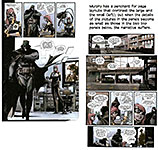

1.jpg)
2.jpg)
1.jpg)
2.jpg)
3.jpg)
5.jpg)
1.jpg)
2.jpg)
A.jpg)

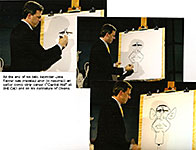
3.jpg)
4.jpg)
5.jpg)
